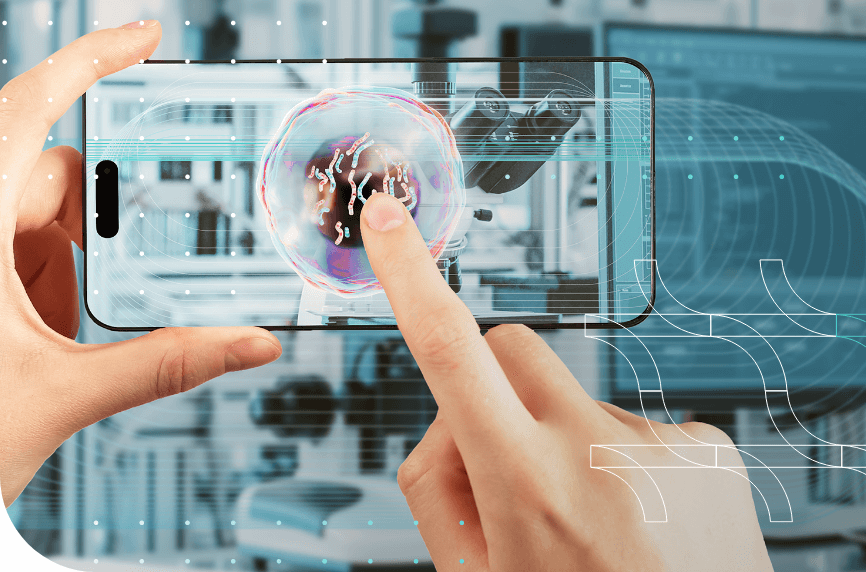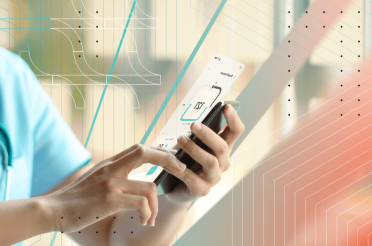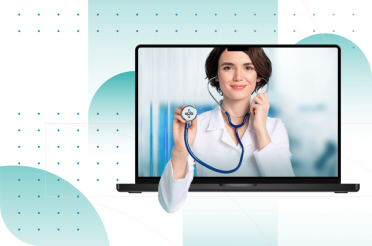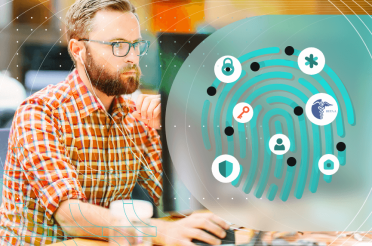The technology humanity possesses is rapidly improving as time goes on. Today, one can enjoy powerful computers capable of running comprehensive simulations for virtually no cost. Because of the availability of such simulations, businesses have started using augmented reality simulations to improve their productivity.
The healthcare sector is not behind in using virtual reality for medical purposes. AR technologies are expected to grow their market share from $1,605.9 million in 2022 to $5,734.9 million by 2028. So, what is this healthcare tool?
What is augmented reality (AR)?
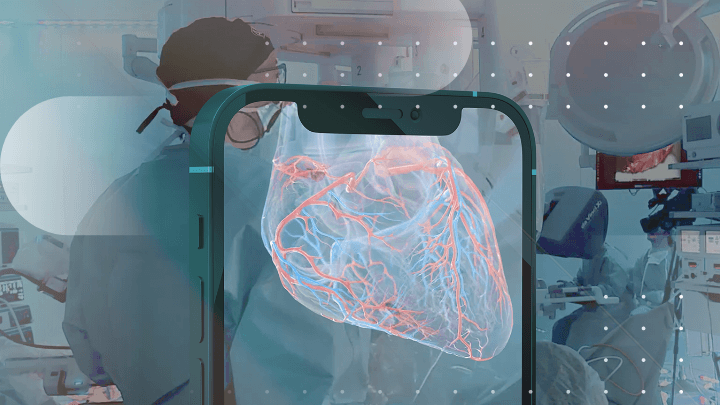
Augmented reality is just a simulation displayed in the person’s vision. It is to be distinguished from virtual reality, which creates an entirely virtual environment, and a person cannot see anything from the real world. Augmented reality puts virtual objects on top of the real-world environment.
An example of augmented reality is AR tools that can display human veins on top of a patient’s body to help medical professionals administer injections. AR technology can also display MRI data, CT scans, or other patient data in a 3D format.
What are the benefits of AR software?

Augmented reality can be beneficial to every medical field:
- Traditionally, medical education includes lectures, textbooks, and training on live models or cadavers. Studying involves learning a lot of dry information, which does not capture the attention of the students.
- Healthcare professionals use medical imaging and physical examinations for a diagnosis which risks missing information due to limited imaging.
- Patient care involves educating patients through verbal and written instructions, which can be challenging for illiterate patients.

Maximise AR’s applications in medical education and imaging.
Stop worrying about how to integrate AR into your practice and get ready to overcome technological challenges by letting one of our strategists help you.

Healthcare AR can address these issues:
- Improved education. Medical students can use a dynamic holographic model to visualize the human body and manipulate it in real-time. This provides a much more hands-on experience for students. They can learn and make mistakes in patients that can be potentially fatal. All of which lead to a more engaging and meaningful education
- Augmented diagnosis. AR solutions can display information on real-life images as by displaying medical data on an MRI scan, a doctor can more easily understand a patient’s anatomy. Different AR tools can help a doctor with complicated cases such as tumors by displaying more information than traditional imaging methods. All of which will assist doctors in providing an accurate diagnosis.
- Improved patient care. Experts need to educate patients to provide treatment. Augmented reality applications are used to provide interactive patient education that can better display their condition and treatment options.
- Increased efficiency. AR can provide updates and feedback in real-time and eliminate the need for several manual tasks. Experts can then focus on patient care, thus increasing efficiency.
- Accessibility. AR-based apps are available on almost every medium – phones, tablets, computers, headsets. Thus, students, experts, and patients can have access to augmented reality from almost anywhere.
- Cost-effective. Having a digital model of education can be much cheaper than using live models. Once created, an AR model can be reused infinitely, with almost no costs.
It is vital to say that AR technology is new, and many people may not see how these benefits are achieved. The listed benefits may thus sound vague. For this reason, the article will focus on specific AR applications and their use in healthcare.
AR applications in medical education

Lectors use AR for three main types of education.
Anatomy training
AR apps can display a virtual model of the human anatomy. Students can study human anatomy while interacting with the model. Basic anatomy such as organ location can be displayed in a simple format.
As a result, the medical training includes:
- less reliance on textbooks and lectures
- more hands-on experience with the human body
- spatial orientation for the different organs and systems in the body
Surgical training
Many operations can be life-threatening if done incorrectly. However, through augmented and virtual reality, students can attempt detailed surgical processes without fear of mistakes. More interestingly, students can be trained in situations where something went wrong, without the fear of losing a patient.
Collaboration training
Beyond surgical simulations, students can work with medical practitioners virtually. They can work with doctors, nurses, and therapists to see the different professions firsthand and develop collaboration skills. For example, students can participate in collaborative surgeries together with a trained primary surgeon.
Augmented reality in medical imaging

AR is not only for students but practicing doctors utilize it as well. Some examples of the software in use are the following.
Medical imaging in surgery
AR can be used to overlay information over a real-world surgery and provide guidance and feedback on the procedure in real-time. This can be crucial when a surgeon is operating near critical areas where the software can help to navigate around blood vessels or nerves.
The AR apps provide a comprehensive view of the patient’s anatomy and thus increase the success rate and safety of an operation.

Integrate AR into your patient care strategies
Improve patient outcomes by learning how to use Augmented Reality by scheduling a consultation with one of our BGO experts.
Preoperative planning
AR can overlay information over images of a patient’s CT or MRI scans and thus provide a more comprehensive view of the patient’s anatomy. Experts can then create a plan for the procedure and have it ready during the surgery.
AR applications in patient care
Patients can also enjoy the services of augmented reality. Many patients are uneducated about their symptoms or have difficulty understanding medical terms. Some simply cannot express their symptoms. AR can help in a lot of ways.
Understanding symptoms
Doctors can use AR to help show how a different symptom looks, and patients can confirm whether they experience a similar feeling. For example, AR can simulate various eye conditions in the patient. Once a patient understands the possible symptoms, they can better describe which one they are experiencing.
Patient education
AR can create interactive models and provide an engaging experience for the patent. They can simply describe symptoms through pictures for the patient who is illiterate or simplify complex conditions so the patient can better understand them.
These models can also visualize how a different treatment option will undergo. A patient can then observe each option and make an educated decision.
Patient rehabilitation
Virtual models can help patients re-learn skills they may have forgotten during treatment. By using AR patients can recreate virtual environments where the patient can practice balance and coordination or practice in a simulated scenario.
These are safe environments for patients that can be modified at any time. As a patient progresses in their treatment, the simulation changes to accommodate the patient’s new abilities. The model also collects the patient’s data, and a physician can then evaluate it.
Patient self-care
Patients can also volunteer to help themselves independently. Physical can therapy and psychotherapy are the two areas where self-care is beneficial. Patients are shown an AR camera display of their bodily movements. Patients can then refine their fine motor movements.
AR in mental health
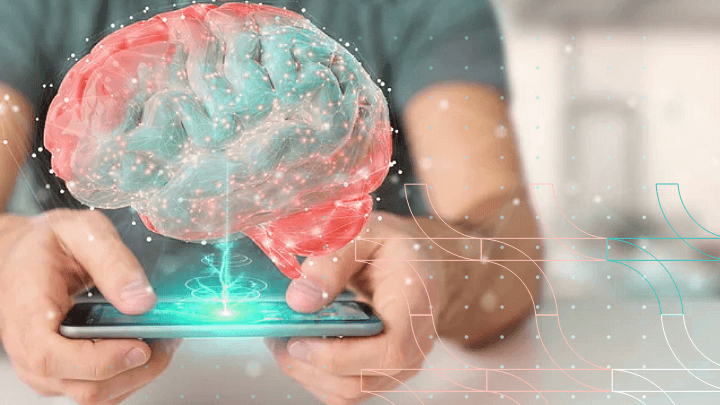
Patients can also be treated for mental illnesses with augmented reality. Healthcare professionals use the software to help treat mental illnesses. Examples of the software being used in the field are the following.
Exposure therapy
Unlike using the software for rehabilitation, where doctors use AR to teach new skills. Here a patient is exposed to their fears and phobias. It allows patients to gradually confront their fears in a virtual format. Patients are exposed to snakes and simulated high places. Gradually, the intensity of the simulation is increased, until the patient has improved
Cognitive therapy
Patients can change their behavior without having a fear to face in a simulation. A person may be required to show compassion to themselves or others in a situation. These tests have then been linked with increased cognitive function while reducing stress and anxiety.
While all of these features are currently applications of augmented reality in healthcare, the technology is constantly evolving. For this reason, the article will now focus on some future technologies that are around the corner.
Future developments in AR technology for healthcare, including potential advancements in AR devices and software
Several different uses for augmented reality are being developed. Some examples include the following.
Augmented reality in dental care
The healthcare industry has started using AR in dental education, pre-trials, and operative dentistry training. In the future, the technology is expected to help with oral, orthognathic, and maxillofacial surgeries.
Dentists can use the technology to identify orifices in root canals. AR can also help dentists place brackets through a 3D identification of the patient’s teeth. AR can enhance the spatial awareness of a professional which is so crucial in dentistry.
AR devices
Currently, people use devices such as phones, tablets, and or glasses. However, in the future, there is the possibility to use specialized medical devices developed for healthcare. For example, researchers are developing contact lenses that can overlay information in real-time without needing head-mounted displays.
AR software
The most important area of augmented reality is software. As technology advances, the clarity and accuracy of the information displayed by AR will improve. All of which will increase the accuracy of diagnosis and medical procedures and improve treatment outcomes.
Telemedicine
As telemedicine increases in popularity, the AR market will need to adapt. Virtual solutions have the capability of revolutionizing remote care. For example, healthcare organizations can use augmented reality to make consultations and diagnose patients remotely. The technology can also allow doctors to give guidance to each other during complicated procedures.
This technology has major implications for patients who have difficulty moving. The technology will also be crucial for remote areas with no access to healthcare. Healthcare services can become widely available through AR video conferencing, improving treatment outcomes
Artificial Intelligence
AR and AI can be combined to provide an even more immersive experience. Artificial intelligence could be used to create simulations that can change independently, without manual input. AI could also contribute to the creation of more comprehensive and realistic simulations.
All of these developing projects promise to expand on the already impressive AR capabilities. Yet, there are some issues common to each technology.
Challenges and limitations of AR technology in healthcare
While healthcare augmented reality can have positive effects on patient care, we must not forget the potential downsides of using such technology. Therefore, the article will focus on several challenges AR faces and present solutions:
Cost of implementation
While replaying already created simulations is nearly free, a hospital must first acquire the equipment for AR. Headsets, eyewear, funding for product development, research, and marketing all factor into the cost of AR. As the technology is in its infancy, the cost is naturally higher.
However, many hospitals are investing in technology and are giving more and more money each year, allowing them to buy such gear. Furthermore, this interest in the technology will put a demand for more development, putting the prices down – in fact, some third-party companies are already developing budget options.
In a worst-case scenario, even if the initial cost is high, the benefits of AR outweigh the negatives as the increased quality is an investment into the future of the healthcare facility. Clients naturally search for places with the best care.
Technical limitations
This could include a variety of issues – the size of an AR system could be too big for a certain facility. Sometimes the opposite is true, VR and AR systems cannot provide immersion and accuracy on a small phone. Other facilities might experience issues with compatibility between different systems.
To solve these issues, the medical field has started developing its software and hardware for the specific purposes of a clinic. Furthermore, any issues related to software can be addressed with the use of a trusted IT partner.
Lack of knowledge
The software can only be as useful as the clinical personnel is prepared to use it. However, most patients, doctors, or healthcare personnel have never used the technology.
Yet, the software is very intuitive. People can usually get the hang of working with it on the first try or for a couple of hours at most. For this reason, as hospitals introduce more AR devices, people will adapt quickly. After all, the software is designed to be as intuitive as possible.
Accuracy
As with every new technology people have concerns with its accuracy and reliability. Unreliable or inaccurate software AR can lead to false diagnoses and errors. However, mistakes in a hospital environment can often be life-threatening or costly for the facility.
Naturally, these concerns must be taken into account. However, setting up test periods for the technology and slowly introducing it can be a way to mitigate these concerns. After the test period and as augmented reality gets more accurate, hospitals will be more willing to rely on it.
Legislation
When working with technology that can be incorporated into almost every branch of healthcare, regulations will be a major hurdle in the development. Especially since working with AR also involves working with the personal data of patients, hospitals must be careful with the implementation.
It must be stressed that legislation only slows down the implementation of the software and does not halt it. Such slow introductions are not a novelty in healthcare, and that alone should not deter investors from the technology. If nothing else, the ever-growing market share is an indication of this trend.
Resistance to new technology
A similar issue to the lack of training is the resistance towards new technologies many people from the older generations have. This can potentially be an issue since both healthcare providers and patients can be resistant to new tech.
In practice, this has not yet been a major issue. AR is not created to target a specific demographic and thus there is no problem with implementing it in a hospital.
There are also a lot of enthusiastic early adopters which offset the reluctance of some people. Lastly, hospitals should not shy away from technology, simply because it is new.
Motion sickness
An element common to most AR devices is that they could not be worn for long periods. Doctors can experience motion sickness, nausea, and disorientation from using a headset for prolonged periods.
This is an issue common to all fields of AR and VR. Unfortunately, it is an issue related to human biology and the fact that we have not evolved to use AR. In this field, further developments and technologies will need to be made. In the meantime, solutions are taking regular breaks from augmented reality or not using it extensively.
In general, it seems that the benefits of AR far outweigh the potential drawbacks. Most of the issues with the software can be solved similarly.
The need for a trusted partner
Be it the cost of implementation or technical issues, a hospital can rely on an IT partner to handle these issues for them. When it comes to handling technical issues or legislation, a software company specialized in healthcare can provide the required service.
After all, technical issues and legislation are common to every technology in healthcare, and an IT company will have more than enough experience in tackling these issues.

Whether you’re a startup, a Fortune 100 company or a government organisation, our team can deliver a solution that works for you.
BGO Software
For these reasons, a medical facility can save a lot of work and resources in developing its infrastructure by outsourcing the work to an IT partner. In that field, BGO Software is one of the leading experts.

